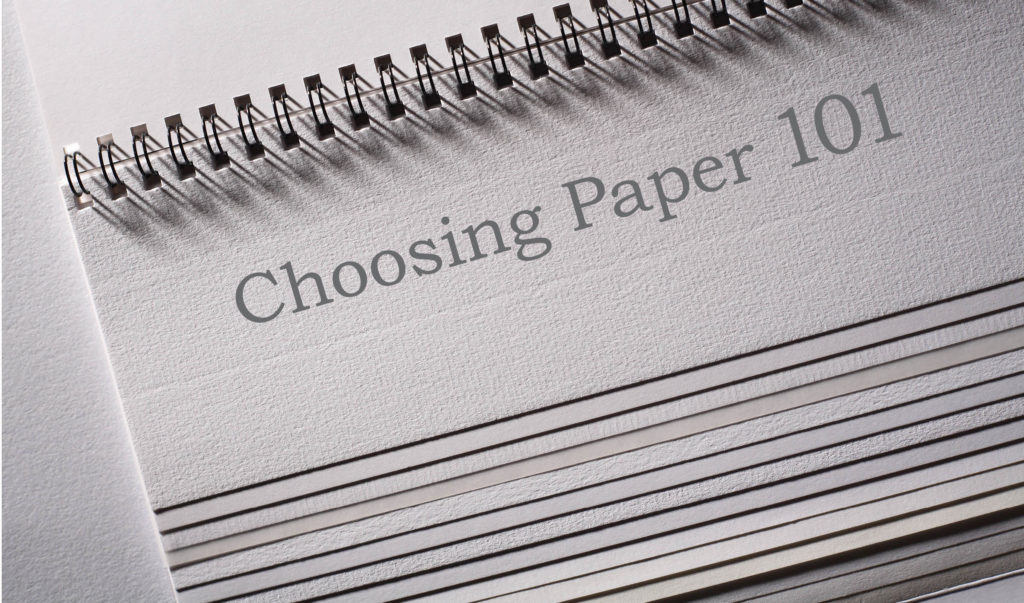An Inside Look at Choosing Paper for your Print Project

Paper, there’s more to it than “basic copy paper”. When it comes to print projects, one of the first and more important decisions you will make is choosing the right paper. After all, when it comes to printed materials, paper type and quality are as important as color and design in the way it impacts brand impression and your overall budget. The type of paper you choose will have an impact on your project’s outcome, including the budget, so it’s essential that you select the appropriate paper for your needs. You want to be sure to choose a paper that fits both your project’s purpose and design aesthetic. Let’s look at how to choose the right paper for your next print project.
Before you begin your project, consider these questions to help choose your paper.
- Will the recipient need to write on the piece?
- Will you be mailing your project?
- Will your piece need to be die-cut or perforated?
- What is the budget for your finished project?
- How long does your project need to last?
- Who is your intended audience?
Answering these questions will help you decide the paper weight and finish.
Weight: What Is It?
Paper weight and finish are two important components to consider first when choosing paper for your project. The weight of a sheet of paper is expressed in pounds (lbs). The higher the number, the thicker and heavier the paper. Paper thickness is a measure of how many hundredths of an inch thick a sheet of paper is. Paper comes in text weight and cover weight. Weight is a little harder to define than thickness. The weight is measured by weighing 500 sheets and the amount in pounds is the weight of that paper. For example, 500 sheets of text paper that weighs 60 pounds is called 60 # text. If those 500 sheets are cover weight (or thickness) and they weigh 120 pounds, this is called 120# cover.
Text vs. Cover: How to Decide 
Common uses for text weight vs. cover weight:
- Text: Flyers, Posters, Brochures,
- Cover: Door Hangers, Bookmarks, Packaging, Business Cards, Table Tents
Cover weight paper is often used for the outside of a booklet and text weight is used for the interior pages. For items that will be “handled” such as bookmarks and business cards, choosing a cover weight will create a sturdier and long-lasting piece. Items that will be folded or perforated generally use text weight paper. If you are unsure of what type of paper to use for your project, you should consult a printing professional. Our Account Managers have worked on thousands of projects and are happy to offer suggestions depending on the piece you want to print.
Finish
You can choose coated paper or uncoated. Keep in mind coated does not always mean glossy, you can have a matte coating as well. Common coatings include gloss, satin or matte.
Gloss paper adds a touch of sophistication to any printed material. It has a reflective surface that draws attention and makes colors appear brighter and more vibrant than they would on another type of paper. The gloss finish also helps protect prints from smudging or fading over time. If you want to make an impression with your printed material, then gloss is a great way to do this. Keep in mind if you intend to write on the finished piece, you will not want a gloss coating as these are difficult to write on.
Satin paper offers a softer, more subtle sheen than gloss paper. This mid-level finish gives colors an extra pop while still maintaining an understated elegance. If you’re looking for something that strikes a balance between the shine of gloss and the flatness of matte, then satin might be just what you need.
Matte paper has no shine or reflection whatsoever; it’s completely flat and non-reflective. While this might sound boring at first glance, matte can actually be an excellent choice for certain projects and brands. For example, if you’re printing black-and-white photos or text-heavy documents like newsletters or brochures, matte can provide excellent contrast and clarity without overwhelming viewers with too much shine or reflection.
Each type of paper finish – gloss, satin and matte – offers its own unique benefits when it comes to making an impression on potential customers and clients. By carefully considering these options before selecting a finish for your prints, you can ensure that your marketing materials reflect the image of professionalism that your organization desires.
Choosing Specialty Papers
Other options for paper choices include specialty papers. These papers could have metallic or textured finishes, UV coatings, wood-free, etc. When selecting specialty papers consider how you want your finished product to look and feel in addition to its purpose and intended use. For example, if you’re creating an invitation or announcement that requires a more formal look and feel then consider using stock with a gloss finish or metallic accents like gold or silver foil stamping. If you’re creating something that needs to stand out in terms of texture then consider a textured stock. Linen or felt-finish stocks can add depth and dimension to your project while still giving it that special touch that sets it apart from ordinary printed materials. Visit Neenah Papers gallery to view projects and the types of paper used, for inspiration on your next printed piece.
Considering Cost vs Quality
When choosing a stock, cost should always be taken into consideration but don’t let price be the deciding factor when comparing different options. Remember that quality matters too. In general, higher quality stocks cost more but they also provide superior performance over time. This means they’ll last longer and look better than cheaper alternatives which tend to fade or degrade quickly due to poor ink adhesion or color shifting over time. Knowing this information can help you make an informed decision about what type of stock would best suit your needs.
With this knowledge in hand, you’ll be able to choose just the right type of stock needed for any print project whether it’s business cards, invitations, posters, flyers, brochures, postcards etc. Remember, when selecting a stock, you should not only consider its intended use and budget but also how you want your finished product to look and feel. All these elements combined will determine if it is a successful execution overall.
The right paper is essential to a first impression and your brand. And…. you don’t get a second chance to make a first impression.

